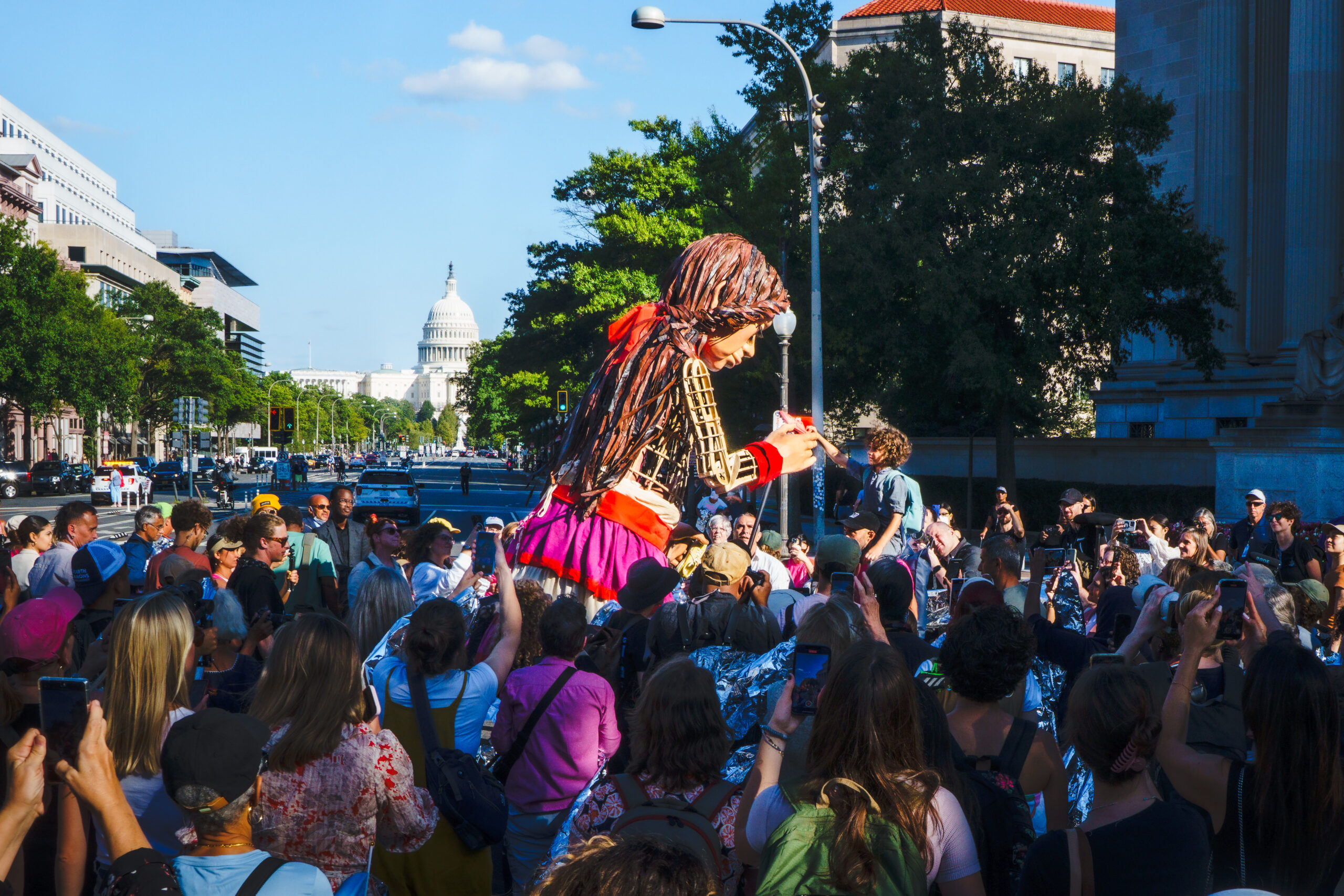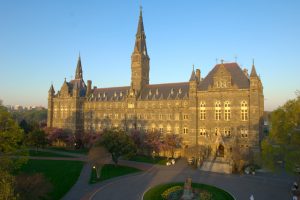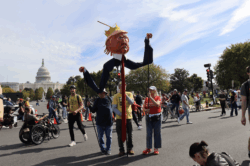Little Amal, a 12-foot puppet of a 10-year-old Syrian refugee, towered above a rustling layer of shining silver safety blankets. Behind the puppet, artists held children’s shoes over the crowd, mimicking the movements of little marching feet. Amal stopped and turned to look out over the crowd behind her, took a breath, and reached down to take a yellow baby shoe from a participant. The puppet raised the shoe to her ear, like how children listen to shells on the beach, encouraging members of the crowd to do the same.
“When we see the shoes without their owners, wondering, what is the story of the owner? And where have they come from? Where are they going? What terrain has that pair of shoes traveled across?” Emma Jaster, associate director of the Laboratory for Global Performance and Politics (The Lab) at Georgetown University said. The Lab seeks to humanize politics through art and performance.
Little Amal has traveled over 6,000 miles since her journey began in 2021 at the Syrian border. As the centerpiece of The Walk–a performance art project by The Walk Productions in collaboration with the Handspring Puppet Company–Amal has traveled to 15 countries. On Sept. 7, she began her journey across the United States in Boston.
Amal’s journey calls attention to child refugees and their stories. “Her urgent message to the world is ‘Don’t forget about us,’” The Walk’s website reads.
During her short visit to D.C. from Sept. 17-19, Amal made multiple stops at events throughout the city. On the last day, The Lab and The Collaborative on Global Childrens’ Issues held a community performance, titled “Little Shoes, Big Journey,” to welcome the puppet.
The first creative choice in planning the event was choosing the location for Amal’s walk, according to Jaster. The Lab decided to walk with Amal from Freedom Plaza to the Capitol building, where she could symbolically speak to lawmakers.
At 3 p.m. on Sept. 19, around 30 Georgetown students took a bus to Freedom Plaza. There, participants picked up used children’s shoes and safety blankets to carry on the walk to the Capitol. Soon, a six-piece go-go band dressed in Georgetown t-shirts and hats began a short set at one end of the plaza.
“Go-go is not just music. It’s a cultural phenomenon,” Natsu Onoda Power, Georgetown professor in theater and performance studies and artistic director of the Davis Performing Arts Center, said. “It emerged after the civil rights movement era, but it has roots in 19th century African American expression, so it’s rooted in D.C.”
Like Amal and other refugee children, go-go music has not always been protected in its birthplace. “It has that history of being born in D.C. under tumultuous circumstances, and being nurtured, but then displaced,” Onoda Power said. Gentrification and law enforcement both contributed to the displacement of go-go music from its place within the city, she said.
“I can’t help but think about the parallel between [Amal’s] world and the world of go-go,” said Onoda Power. “She’s a person who’s been displaced from her native environment and go-go has experienced that as a culture. So I was very happy that these two things met and shared a moment.”
“Join the band, hand in hand, across the land, together we stand,” Georgetown students chanted as they waited for the puppet to arrive in front of the Capitol building.
“Amal comes around the corner and people just start pointing,” Delaney Devlin (SFS ’26) said. “This mystical feeling. Everybody swarms around her immediately.”
Amal made her way through the crowd, twirling in time with the music’s driving rhythms and capturing the audience’s attention. The wind lifted her plastic hair behind her as she reached down to touch children’s hands.
“She really stands out,” Devlin said. “You want to follow. It’s so brilliant to see such a well-made and passionate representation of the struggle of migrants and refugees worldwide.”
Amal led the crowd to walk in the direction of the Capitol. As the crowd followed, people unfolded the silver safety blankets, surrounding Amal in an ocean of silver.
“I came across an image of a young girl at a detention center at the U.S.-Mexico border,” Jaster said. “And the detention center floor was covered in children wrapped in those mylar emergency blankets…and these blankets all together transformed into something else. It was like, ‘Oh my gosh, these are the oceans that we travel.’”
When Amal reached the Capitol, she followed a path of used childrens’ shoes to a small stage. Snippets of interviews with refugee children played on loudspeakers. Above the sound of crashing waves, the children described their home.
“Home means family and happiness and peace,” one child said. “My country feels like playing with my dog and my family,” another said. “A home is where your family lives together with love.”
“They’ve made a figure who is so beautiful but also imposing and grand,” Devlin said about the puppet. “They made a very grand representation of a type of individual, a Syrian refugee girl, who is so little recognized and who is often considered policy and not a person.” At 12 feet tall, Amal calls attention to these stories that rarely find an audience in the Capitol.
Event organizers and representatives Jamal Bowman (D-N.Y.) and Debbie Dingell (D-Mich.) took turns speaking directly to Amal. The puppet nodded and silently laughed during each speech. Each speaker shared a hug with Amal as they left the stage.
Before the crowd dispersed, Somali artist Ifrah Mansour addressed the puppet. Amal reached her arm out to hold Mansour’s head as the poet spoke about her own experience as a young refugee: “I am a refugee. A stubborn survivor. You see, cruelty tried to break me. Wars tried to erase me. Bigotry tried to silence me and politics tried to ban me. But still like time, I stand. Still like Amal, I walk.”





